
It being the 400th installment of this, the "Stupid Comics" feature of Mister Kitty, we thought it might be a good time to take a step back and review our accomplishments, and perhaps look at things a bit differently. That is to say, we've poked a lot of fun at a lot of not-very-good comics. We've all had our laughs at their poor writing, their bad artwork, their ridiculous concepts, and their failure at wringing pocket change out of the youth of many nations. We've gotten a lot of mileage out of a little negativity. So maybe it might be time, just this once, to ask ourselves, what are the not-so-Stupid Comics? What comic books do we love? What comics do we enjoy non-ironically, without snark or sarcasm or our irritating hipster know-it-all attitude? Well, we decided that this is the perfect time to show you some of our favorite comics.
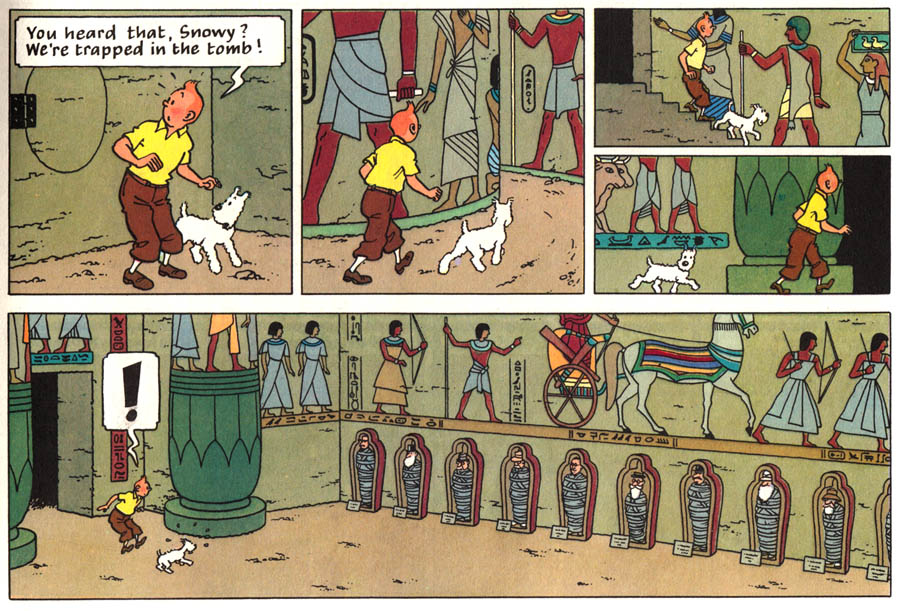
It's kind of a cliche to talk about how great Herge's TinTin comics are, but hey, sometimes cliches are cliches because they're true! I started reading these at about age 9; the waiting room of my dentist's office had the magazine "Childrens' Digest" among the other reading material found in such places, and they ran TinTin in small, black and white installments in each issue. This story is one in particular that stands out in my memory hole, called "Cigar of the Pharaoh", it's one of the most famous TinTin comics. This is clean line at its best, folks! Accept no imitations!
You can find TinTin in the children's section of about any bookstore. It's available in pretty much any language you want, I think.

Another cliche is to talk about how great EC Comics were. Well they were! This story, "Master Race", from Shock SuspenStories, is known both for its grim subject matter and the beautiful, brilliant artwork by Bernie Krigstein. Look at the motion conveyed on this page goddamn!
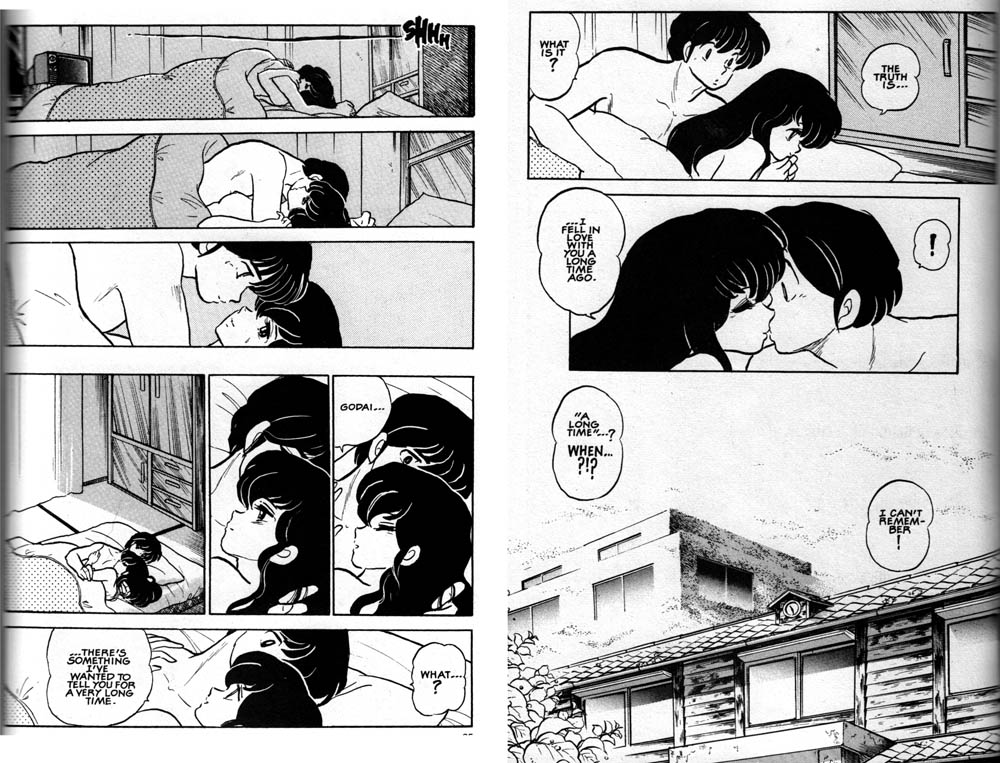
Sorry for the crappy scans on this-- this is from Viz's English edition of Rumiko Takahashi's classic romantic comedy "Maison Ikkoku". Takahashi is of course a manga legend, having drawn massively successful international hits such as "Inuyasha" and "Ranma 1/2", as well as her first huge hit "Urusei Yatsura", but this title stands out to me, if only because it actually has an ending. Also, it's about grown-ups and not high school kids, that helps too. The artwork is charming and cute and the story and characters are really engaging. And these pages you're looking at here are about as sexy as it gets.

Bill Griffith's Zippy the Pinhead is a nice, if somewhat shrunk-beyond-readable-size newspaper strip these days, but he got his start in the underground comics of the early 1970s, where his polkadot muumuu and non-sequitirs were a breath of fresh air among the sex, drugs and mayhem of the rest of the underground scene. Zippy's sense of humour is one of those things, either you get it or you don't. Not even gonna try to explain it but I've loved it since my teen years.

What's Michael by Makoto Kobayashi is another manga I love... parts of it were published in English but the Japanese volumes contain stories deemed unfit for western audiences. This isn't one of those stories, but it's hilarious. Like, you don't even need to understand Japanese to find this funny. (Don't forget to read it right to left). The name of this story, needless to say, is "Michael vs Godzilla". This manga is hilarious because cats really are that stupid.
Gonna get some angry letters for that.

Notice how the only time Richie isn't laughing indulgently at Jackie Jokers is when Jackie is actually exchanging funny lines with Mayda Munny. What an asshole.
We give Harvey comics a bit of a hard time on occasion-- like last week-- but I would be remiss if I did not mention here that a lot of these comics really are genuinely, non-ironically, intentionally amusing. It's not the sort of "we'll drop in sly little jokes for the parents to catch while the kids remain oblivious" type of humour seen in a lot of kids' cartoons these days, it's just genuinely funny no matter your age. And let's face it, a lot of great art appears in Harvey comics. I know there have been attempts made to "update" Richie Rich and his friends for modern kids, but the problem is I think they were probably all ready perfect to begin with. If modern kids don't want to read about extreme megalomaniacs, well... that's probably a good thing actually. But dammit these are good comics.
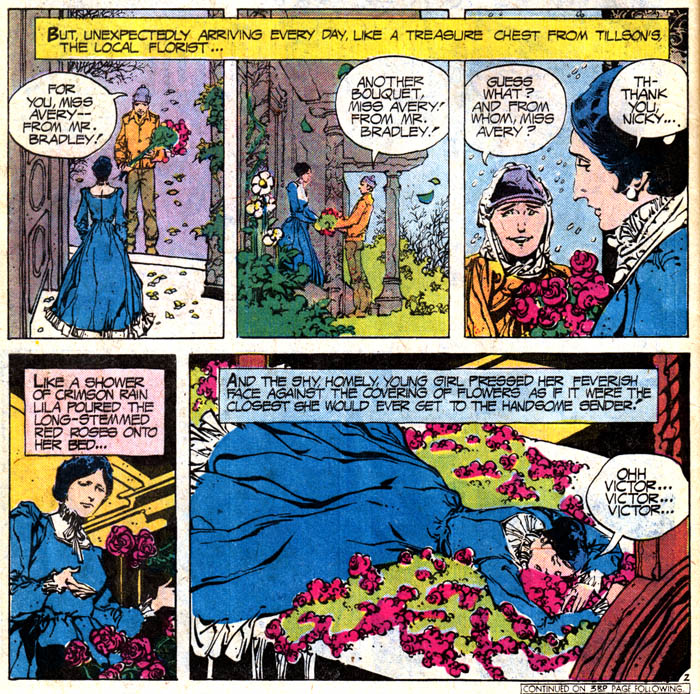
Another well-worn topic here at Stupid Comics are DC's line of "mystery" comics from the 70s but there were actually a lot of really great stories contained in those comics, such as this selection from a 100-pg "House of Mystery", featuring one of my favourite artists, Alex Nino. He was one of several Filipino artists employed by DC at the time, and I love pretty much all of them. Look at those graceful lines, so evocative. There was a great variety of stories in these mystery comics too; anything from a romantic gothic horror like this story, to tales of demon possession, or monsters or pretty much anything else you could affix a "horror" label onto if the word "horror" hadn't been banned by the Comics Code Authority.
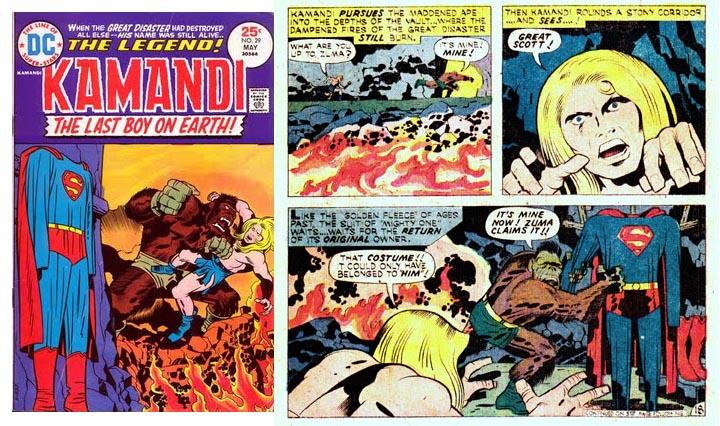
When I was a kid, I was given a choice between two comics, and one of them was Jack Kirby's Kamandi The Last Boy On Earth, and I thought it looked weird and scary, so I didn't buy it, and not a day goes by that I don't regret that decision. Jack Kirby is a titan whose influence continues to shove and manhandle its way through our popular culture, and it wasn't long before even childhood me learned to respect the raw power and dynamism of his decades-long body of work. And I could post fave Kirby comics all day, but the one I want to show off here is Kamandi #29, where the Last Boy On Earth finds a lost talisman of the shattered world and puts everything on the line to save it.
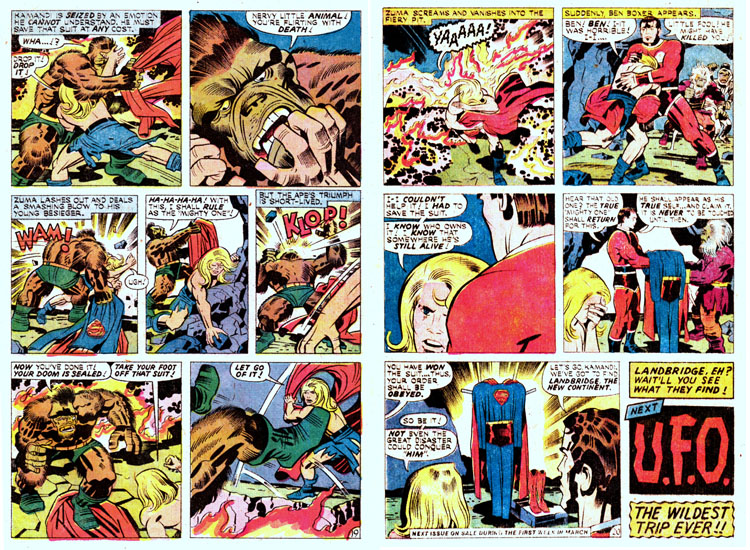
In one 32 page comic, Kirby managed to capture the power of a pop-culture legend AND give us a teenager fighting a crazed talking ape for posession of Superman's costume. This is comic books boiled down to their most distilled essence; gods, monsters, myths, and fire, rendered in four slightly off-register colors. In a perfect world THIS would be the Superman movie we see in theaters, or at least the cartoon before the movie.
Dan DeCarlo is another name everybody should know; Archie Comics is still cashing in on his artistic vision of teenagers as pin-up queens, and not everybody has TV cartoons and major motion pictures starring what's basically his wife's Halloween costume. But before she joined the Pussycats, Josie Jones was just another all-American teenager with her own comic book.

Josie, Pepper, Sock, Melody, Albert, and even Alex and Alexandra goofed their way through book-length adventures in the first thirty or so issues of Josie; a mid 1960s snapshot of what teenagers wore, listened to, and hit each other with in a world still untroubled by Vietnam or hippies. I like all DeCarlo's work but my personal feeling is that this run of Josie is his peak.
Meanwhile across the river in Duckburg;

Carl Barks wrote and drew comics starring Walt Disney's Donald Duck and his various relatives for nearly 25 years, mostly as an anonymous Western Publishing freelancer. Mercifully, he was left alone to create detailed, world-spanning yet wryly observational adventures for Donald and his Uncle Scrooge, the richest duck in the world. Barks was a superstar comic artist before anyone even knew his name, and decades later his work continues to enthrall and inspire.
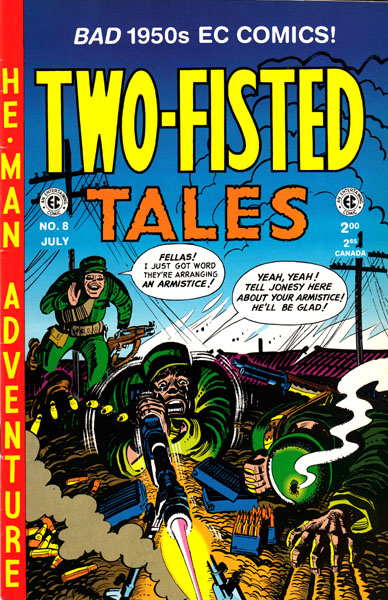
I have a soft spot for war comics and nobody did them better than Harvey Kurtzman, who saw war as a nightmare of terror that left no one unscarred, survivors and casualties alike. With EC'S Two-Fisted Tales, he turned an insipid he-man adventure book into the premiere anti-war comic of his generation, highlighting the waste and destruction with a painstaking eye for historical detail and accuracy. As an editor he brought out the best in all his artists, and as an artist his bold, almost cartoony strokes gave vibrancy to his square, anguished figures.
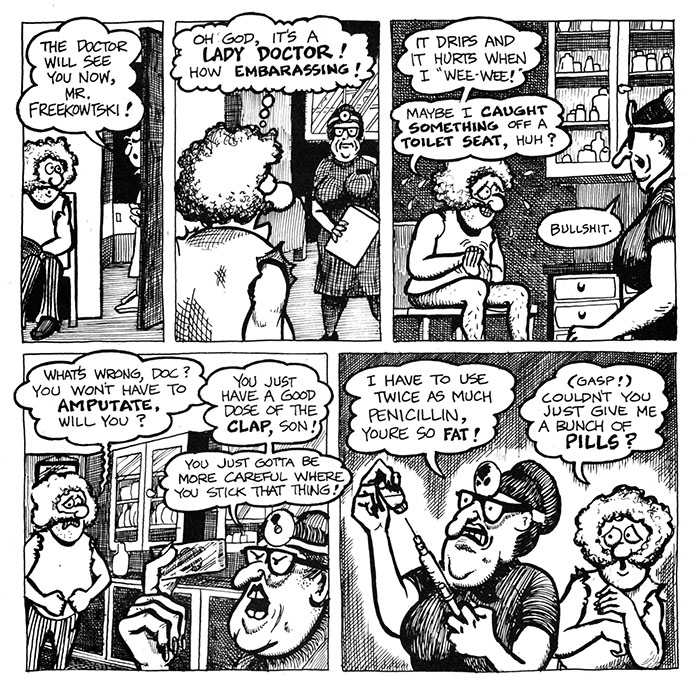
The EC comics of the 1950s inspired a whole new raft of boundary-pushing "underground" cartoonists in the 1960s, among them Gilbert Shelton, whose Fabulous Furry Freak Brothers would survive the 60s, 70s, 80s, 90s, and 00s. The Freak Brothers spent much of their early adventures seeking out and enjoying various illegal narcotics, delineated in Shelton's cartoony, organic style. As the series progressed we found the Freaks getting involved in ridiculous adventures of all kinds, such as the time Phineas decided to produce a science-fiction movie. The apogee of the Freak Brothers, however, must be their long-form full-color adventure "The Idiots Abroad", which involves, among other things, a worldwide revolution, a thinly disguised Pablo Picasso, the May Day parade in Moscow, a Burger King in Paris, modern-day pirates of the Caribbean, a secret volcano commune, and a terrorist with a nuclear bomb disguised as a soccer ball, which Fat Freddy uses as a prop in this astonishing display of footy artistry.
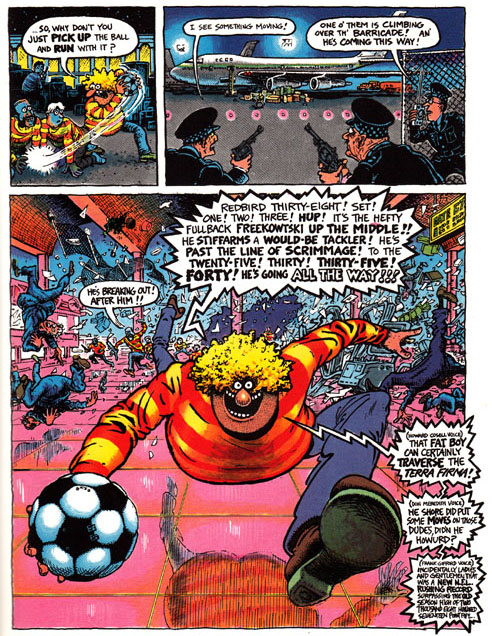
Shelton's assistant on his later Freaks stories was the noted SubGenius savant Paul Mavrides, an artist of protean influences and inhuman skill. His work in the comics form is rare, but to my taste it peaked in the four issues of Last Gasp's Anarchy Comics.
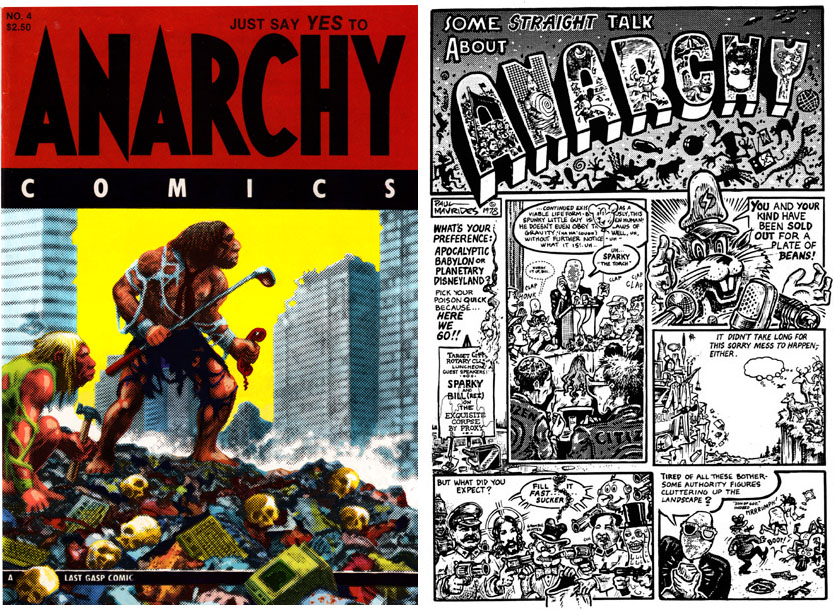
A compendium of comics from all points of the political and stylistic compass, Anarchy Comics proved fertile ground for Mavrides as he collaborated with editor Jay Kinney on several masterpieces of agitprop. His "Straight Talk About Anarchy" is a particular favorite.

Meanwhile, in Atlanta Georgia, noted man-about-town Bob Burden was channelling a lifetime of bad movies, too many nights at the 688 club, and a whole carload of terrible comics into the adventures of the Flaming Carrot, an absurdist Winsor McCay meets Russ Meyer by way of Fletcher Hanks fever dream of Martians, babyheads, jarts with Death, Communist takeovers, and Uncle Billy's mail-order bride Nakiti Gazeebo. The sheer New Wave nonsense of Flaming Carrot was a blast of dada in a comic book field that was and still is taking itself way too seriously, and if there's one thing I miss about the 1980s it's new issues of Flaming Carrot with that great Roxanne Starr lettering.
Also born in the 1980s and still going strong are comics by the two and sometimes three brothers Hernandez...
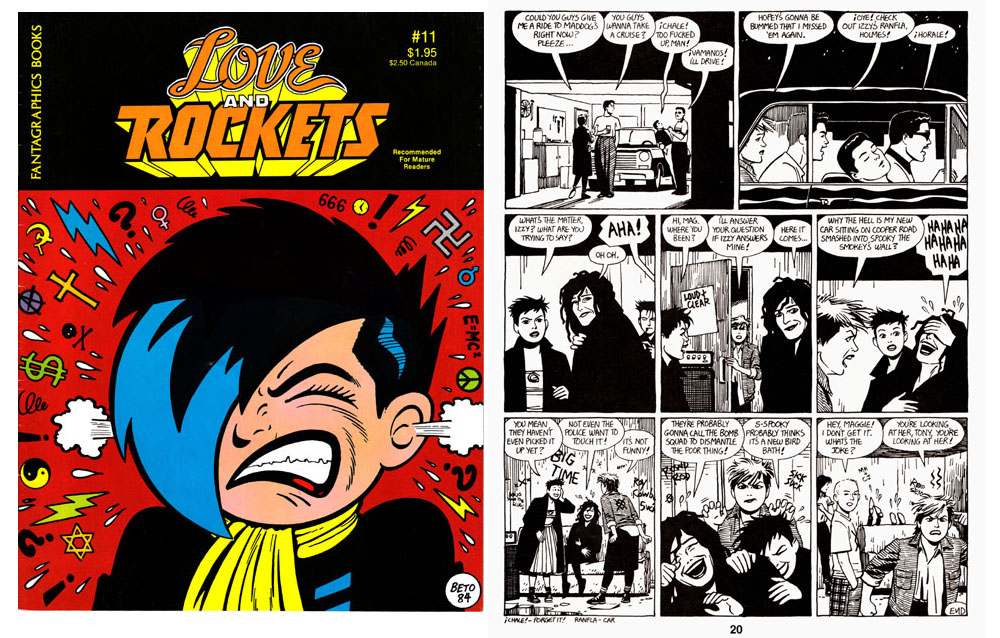
Oscillating wildly between deadpan science-fiction adventure, DeCarlo-style teen punk romance, and social-realist magical-realist drama, Love & Rockets defied categorization and yet managed to grab us right in the gut and make us care about unemployed mechanics or small-town Central American villagers. Jaime recently kicked all our asses with "The Love Bunglers", a payoff he'd been working on since 1984. You magnificent bastard.
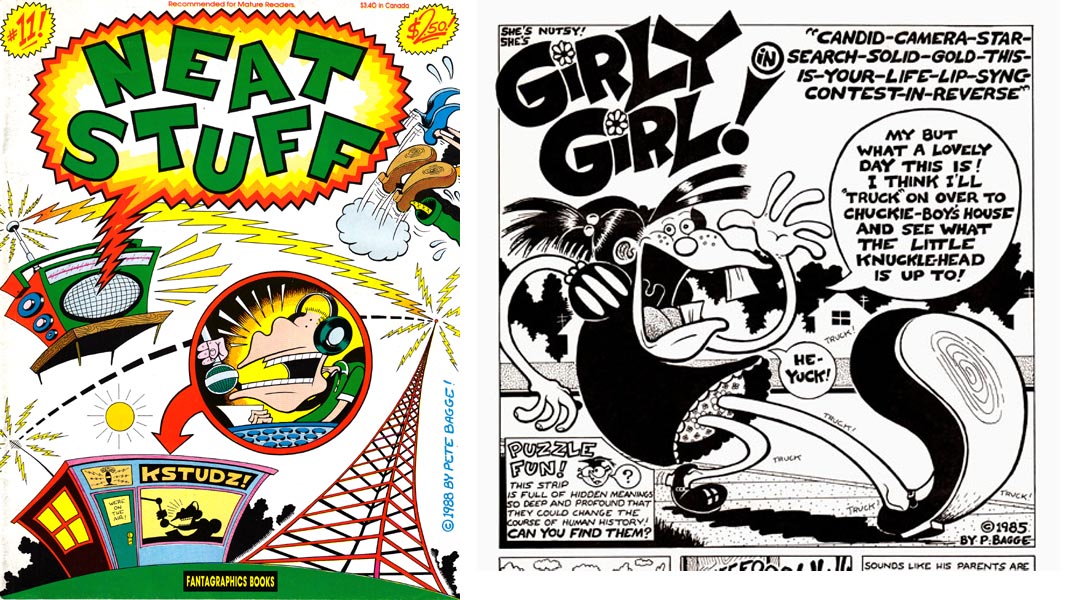
Also from Fantagraphics, with a lot less romance and a lot more goofy buck teeth, former "Punk" cartoonist Pete Bagge cut loose with Neat Stuff, bringing America the crazed, big-foot, cheerfully insane comics it so desperately needed. Neat Stuff featured the adventures of proto-Rush Limbaugh Studs Kirby, the malevolent Girly-girl and her eternal victim Chuckie-Boy, and the always-fighting Bradley family, of whom #1 son Buddy would become the star of Bagge's next comic book, simply titled "Hate." Along with David Carrino, Bagge would also create the greatest comic book character of all time, Martini Baton. Pete Bagge continues to inflict his cartoony attitude on the world with strips for Reason and an upcoming biography of birth control pioneer Margaret Sanger.
Quieter, more obsessive, certainly weirder; that would be Bagge's contemporary Daniel G. Clowes.

Clowes Bernie Kriegstein'd his way through six issues of Lloyd Llewellyn, an entertaining film-noir mid-century-kitsch pastiche of early Kubrick films, bad Dragnet episodes, and back issues of "Superman's Pal Jimmy Olsen". But his second regular book had no time for nostalgia. Eightball drilled its way right into America's hindbrain and projected our jittery 1990s fears onto the comic book page, leavened with a generous dusting of black humor. Clowes blew the lid off the art school racket, profiled TV prayer-huckster Robert Tilton, parodied Harvey Comics and Chick Comics and Image Comics and Fantagraphics and the entire stupid comic book racket, and left us all limbless, blind, and with the Value Ape face carved into our forehead. Two feature films and a couple of screenplays later, Clowes may be the greatest living American.
I haven't really said that much about manga, because as North Americans, the sad fact is that we've only been exposed to the teeniest tiniest bit of the Tokyo Bay Landfill Reclamation Project that is the world of manga. It's hard to judge when our sample size is so small. However, from what I've seen, I have to say one Japanese comic I really enjoyed was Naoki Urasawa's Pluto.

Urasawa was behind Viz's fun Pineapple Army and both 21st Century Boys and Monster (neither of which I have read). Pluto is his take on what many consider to be the seminal Astro Boy story, "The Greatest Robot On Earth". What we're seeing in Pluto is a master graphic novelist at the top of his game tackling what's not just a pop culture icon, but a national treasure.
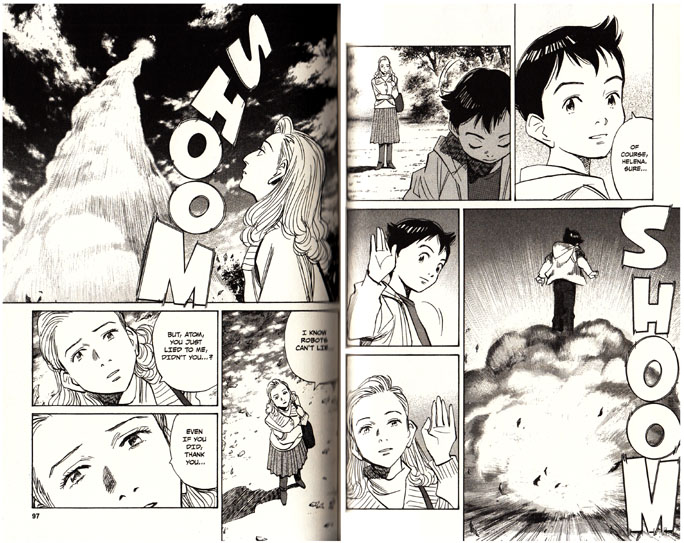
Urasawa brings all these iconic Tezuka characters to detailed, breathing life, and sets the whole rock 'em sock 'em robots story up to echo current conflicts in the Middle East, the utility of extra-national peacekeeping, and the eternal sci-fi question of what does it mean to be like the hu-man. Love, death, vengeance, redemption, and the nature of being itself are what Pluto brings to the table. That, and Astro Boy in a hoodie.
This by no means is a complete list of our favorite comics. The fact is we love the things, bad or good. We probably wouldn't have made it through 400 installments of "Stupid Comics" if we didn't hold some affection for even the stupidest of Stupid Comics. Thanks for reading, and we'll be back next week with some genuine badness!
PREVIOUS STUPID COMICS
NEXT STUPID COMICS
BACK TO STUPID COMICS INDEX
BACK TO MAIN INDEX






















